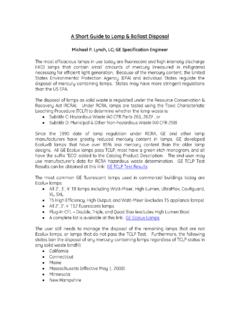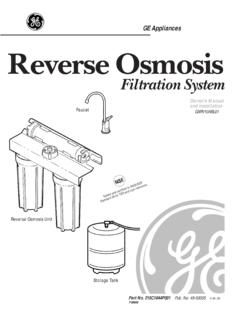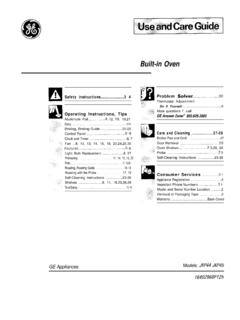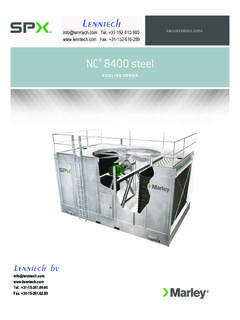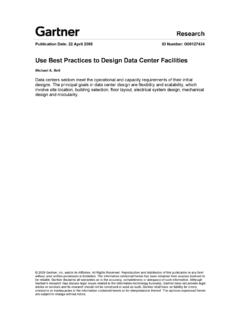Transcription of GE Zoneline vertical packaged terminal - GE Appliances
1 GE Zoneline vertical . packaged terminal air conditioners Architects and Engineers data manual Specifications Electric resistance heat Heat pumps 230/208 Volt Models AZ75E09 DAC AZ75E12 DAC AZ75E18 DAC AZ75H09 DAC AZ75H12 DAC AZ75H18 DAC. Features BTUH 9,500/9,300 11,700/11,500 17,500/17,200 9,500/9,300 11,700/11,500 17,500/17,200. (BTUH/Watt) Dehumidification (pints/hr.) Universal Heater (kW) Heating Cap (BTUH) 8,400/8,200 10,900/10,700 15,700/15,500. COP @ 47 Voltage (V) 230/208 230/208 230/208 230/208 230/208 230/208. Unit Width (in.) 23-1/8 23-1/8 23-1/8 23-1/8 23-1/8 23-1/8. Unit Depth (in.) 23-1/8 23-1/8 23-1/8 23-1/8 23-1/8 23-1/8. Unit Height (in.) 32-1/4 32-1/4 32-1/4 32-1/4 32-1/4 32-1/4. Indoor CFM (Hi/Lo) 0" ESP 310/260 375/315 550/475 310/260 375/315 550/475. 265/277 Volt available by special order.
2 265/277 Volt specifications similar to 230 Volt. AZ75E09 EAC AZ75E12 EAC AZ75E18 EAC AZ75H09 EAC AZ75H12 EAC AZ75H18 EAC. 265 Volt Models Electric resistance heat Heat pumps Features BTUH 9,500 11,700 17,500 9,500 11,700 17,500. Watts 950 1095 1750 950 1095 1750/1720. Cool Amps Dehumidification (pints/hr.) SHR .70 .67 .71 .70 .67 .71. Reverse Cycle (BTUH) 8,400 10,900 15,700. COP @ 47 Indoor CFM (Hi/Med/Lo) 310/260/230 375/315/250 550/475/440 310/260/230 375/315/250 550/475/440. Ship Wt. 152 165 174 152 165 174. Net Wt. 141 154 163 141 154 163. 265/277 Volt available by special order. Zoneline vertical Unit Nomenclature The Zoneline vertical unit is identified by a model number defining the type of unit, cooling capacity, and electrical information. When specifying or ordering the Zoneline vertical unit the use of this nomenclature will assure receiving the correct unit.
3 EXAMPLE. A Z 7 5 E 0 9 D A C. Zoneline Chassis series Nominal cooling capacity Heater packaged 75= vertical 09=9,500 BTUH cooling configuration terminal unit 12=11,700 BTUH cooling A= Universal heater 18=17,500 BTUH cooling See power Unit type connection kits E= cooling with electric section resistance heat H= heat pump with electric Voltage/Phase/Frequency Special Features resistance heat D= 230/208 Volt, single phase, 60 Hz C= corrosion protection E= 265 Volt, single phase, 60 Hz Other components are necessary for a complete installation - see System Essential Components section. Listed by LY. ING. MA NUFA. WITH. Underwriters'. Laboratories.. Table of Contents Front Cover 1. Mini-Specs/Nomenclature 2. Table of Contents 3. Introduction 4. GE Zoneline vertical packaged terminal Unit.
4 5. Features and Benefits 6-9. System Essential Components 10-12. Accessory List/Unit Specifications 13. Air Flow Table/Dip Switches/ terminal Block - Line Art 14. Required Accessories Line Art/Expanded View 15. Utility Closet and Dimensions 16. Suggested Bid Form Specifications 17. Additional Specifications 18. Warranty 19. Important Notice Equipment used as a primary source for heating or cooling is an integral part of the building in which it is installed. Proper application is essential for satisfactory performance over a wide range of operating conditions. It is strongly recommended that a professional engineer determine proper application. If this unit is a replacement unit, its specifications and performance may differ from those of the unit it is replacing. For that reason, we again strongly recommend that a professional engineer determine proper application.
5 Introduction Today, guests in lodging properties, assisted living facilities and apartments desire rooms with a more home-like appearance. They expect the comforts they are accustomed to, whether they spend one night or many years. Toward that end, many lodging properties provide refrigerators, microwave ovens and remote control televisions. Many assisted living facilities provide full-size kitchen Appliances in each individual apartment. All of these improvements are an attempt to improve the comfort and satisfaction of the occupant by providing a more home-like environment. Upgrading the air conditioning and heating provides another opportunity to enhance guest comfort. Years ago, an acceptable means of creating a comfortable environment was to install a window air conditioner and an electric heater mounted on the wall.
6 The GE Zoneline was the first packaged terminal air conditioner introduced to the market, and it led the way in improving comfort and efficiency. And they are still used extensively as an alternative to large, expensive central systems. However, there are some inherent issues with packaged terminal units. First, since all of the components are contained in the chassis, the compressor and fan sounds can be heard in the room. In addition, since the units are usually mounted under the window there are limitations to furniture placement and curtains cannot hang to the floor. Finally, some people find the controls difficult to adjust for the desired temperature. The vertical packaged terminal Air Conditioner To address these issues, GE has introduced the vertical Zoneline . It is still a through-the-wall, packaged terminal unit, but instead of being 42" wide and installed in the middle of the room, it has a vertical configuration and is installed in a closet-like corner enclosure.
7 The GE Zoneline vertical packaged terminal Air Conditioner (ZVAC) is approximately 24" x 24" and has a top air discharge that is ducted into a single room or multiple rooms. It is controlled by a wall-mounted thermostat similar to those found in most homes. Because the new ZVAC is installed in a closet, it provides a more home-like appearance to the room as well as quieter operation. And guests prefer the wall thermostat because it provides more precise settings. Since the vertical Zoneline is not installed under a window in the middle of the room, curtains can hang all the way to the floor, and more versatile room designs are possible. Because the unit is ducted, it can serve a single room or multiple rooms. The GE Zoneline vertical packaged terminal Air Conditioner is a great option to standard PTACs for cooling and heating a variety of rooms.
8 It provides the costs benefit of packaged terminal units with the aesthetics, quieter operation and flexibility of a central system.. The GE Zoneline vertical packaged terminal Air Conditioner . The GE Zoneline vertical air conditioner is available in 9,500 BTUH, 11,700 BTUH or 17,500 BTUH cooling capacity with either resistance heat or heat pump units with resistance heat backup. Each cooling capacity is available in a dual rated unit that operates on either 230 volts or 208 volts and in a unit designed to operate on 265 (277) volts. All units are equipped with a 3-element universal heater that provides kW or kW or kW when connected with the appropriate 9-pin power connection kit to 230-volt or 265-(277) volt power. The dual rated 230/208-volt unit will produce kW or kW or kW when connected to 208-volt power.
9 See page 12 for information on the power connection kits. System Features System Essential Components The ZVAC has a number of features that help distinguish Installation Platform it as the leader in the vertical unit industry. Each feature is Wall Plenum discussed in detail in the Features and Benefits section. Exterior Grille Excellent efficiency and dehumidification Chassis Unique sleeve design for easier installation and service Case Three-way slide-out chassis service/maintenance flexibility Power Connection Kit Electronic Temperature Limiting (requires room air Remote Thermostat temperature sensor accessory - RAVRMS). Filter Freeze Sentinel (requires room air temperature sensor accessory - RAVRMS) Return Air Grille Constant ON fan (required in nursing homes in some states) Ductwork Permanently Lubricated Fan Motors Supply Register Standard Size Air Filter Central Desk Control Capability Occupancy Sensor Interface HI and LOW fan speeds controlled by remote thermostat 3-Speed Indoor Fan Motor for selectable HI and LOW speeds Corrosion Protection Treatment Standard Slinger Ring Condensate Removal Indoor Frost Control Automatic Compressor Random Restart Compressor Restart Delay Quick Heat Recovery (On Heat Pump Units).
10 Extended Heat Pump Operation Reverse Cycle Heat Pump Defrost Warranty (including both parts and labor).. Features and Benefits Excellent efficiency and dehumidification The limits are set by dip switches located on the ZVAC unit and are not accessible by the room occupant. Location of the dip GE recognizes the importance of energy efficiency and switches and the temperature settings are shown on page 14. dehumidification in an air conditioning system. The ZVAC. unit is rated in accordance with ARI (Air Conditioning and Refrigerating Institute) Standard 310/380-93 which uses cooling Temperature Limits degrees F. EER (Energy Efficiency Rating) as a means of reporting the Min 60o 64o 66o 68o 70o 72o 74o 76o relative cooling efficiency of the unit. Max 85o 85o 85o 85o 85o 85o 85o 85o EER is the rating system used for packaged terminal Air Conditioners and Heat Pumps.
